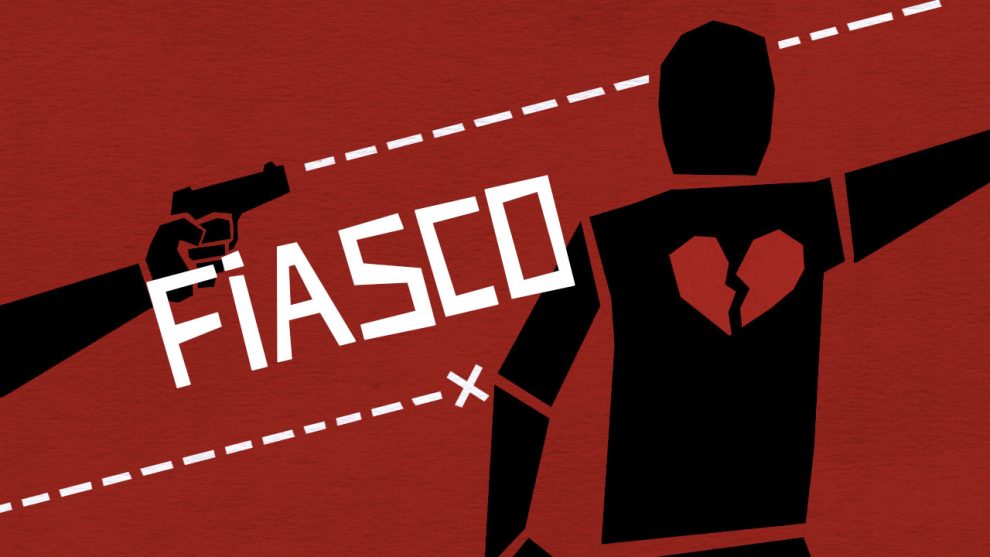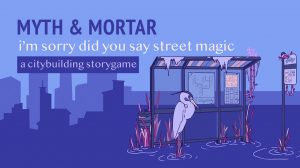It’s late. Jimmy’s old clunker is running hot, and his fingers drum the dash with a growing frenzy. I said get the goods and get out. Come on, Frank, where the hell are you. His eyes dart from the empty passenger seat to the door outside, now hanging off-kilter from its busted hinges. By the time he hears the click of the pistol from the backseat, it’s already too late.
***
Saying “Fiasco is a role-playing game” feels like a cheap way to describe it. A modern classic in the world of collaborative storytelling, Fiasco creates a dense web of plots, characters, and truly human stories that come to life and self-destruct in the span of three hours. To give you a sense of the kind of stories Fiasco tells best, I’ll let the publisher’s blurb speak for itself:
“Fiasco is inspired by cinematic tales of small time capers gone disastrously wrong – films like Blood Simple, Fargo, The Way of the Gun, Burn After Reading, and A Simple Plan. You’ll play ordinary people with powerful ambition and poor impulse control. There will be big dreams and flawed execution. It won’t go well for them, to put it mildly, and in the end it will probably all go south in a glorious heap of jealousy, murder, and recrimination. Lives and reputations will be lost, painful wisdom will be gained, and if you’re really lucky, your guy just might end up back where he started.”
There’s a lot of bold claims there – Fiasco delivers on all of them. With the brand new boxed edition of Fiasco set to Kickstart this July, now seems like as good a time as any to take a look into this deeply influential game of big dreams and bigger disasters.
The safe clicks softly as Frank’s practiced hands run over the worn dial. Left, left, right. A bead of sweat runs down his brow. One more turn and he’s in.
The Book
As of the current printing, Fiasco comes in a slim sleek book of around 130 pages. The iconic Saul Bass-inspired cover art is a nice hint of what you’ll find inside: the whole book is peppered with the minimalist illustrations of graphic and game designer John Harper (best known now for his own RPG Blades in the Dark).
The book offers a few different paths through its rules. The writing is punchy enough (and insightful enough) that I would recommend anyone read it in its entirety, but Fiasco also provides a few helpful shortcuts for experienced story gamers and other eager readers. The text provides subtle hints about role-playing that you may not have thought about before. When the book tells you that scenes exist to answer questions, directly or indirectly, it’s guidance on how to play Fiasco – but it’s also fantastic advice for role-playing games in general.
About twenty pages are devoted to a real play session; an extended look at a game of Fiasco from open to close. While this is hardly necessary in 2019 – Fiasco’s popularity has generated dozens of fantastic actual plays that you can enjoy – nothing beats a little hands-on tutorial from the source.
The last important thing that comes with the book is a generous selection of what Fiasco calls Playsets. These are essentially lists of prompts that players use to establish the premise of the game they’ll be playing. While there’s enough in the book for a myriad of stories, there’s a lot of supplemental content available online for those who want to mix things up. The publisher, Bully Pulpit, offers a swath of free Playsets on their website.
The safe opens with a creak loud enough to make Frank wince. He reaches a hand in to grab the papers, but there’s nothing there – cold steel. “Looking for these?” Anywhere else, the voice behind him would be friendly, even comforting… but here, it sends a chill up his spine. Oh god, thought Frank. Lisa.
The Setup
Let me start with this: there are plenty of options for instant-starts in Fiasco. No setup, straight into play. But I don’t want to talk about those. Why? Because Fiasco’s setup is a delightful act of world-building, and it really contributes to making the story feel like your own.
Something important to understand about Fiasco is that there’s no “default” setting for your game. Do you want your drama to unfold in the wild west? A city of superheroes? A sleazy crime syndicate? A space station? A small town? Fiasco manages to turn all of these into a compelling place to tell your story. To start off your setting, any session of Fiasco begins with the selection of a Playset.
Each Playset comes with four lists of prompts: relationships, needs, locations, and objects. These prompts will be specific to the setting you’ve chosen. At the start of a session players take turns selecting prompts; any prompt you choose is something that connects your yet-unknown character with that of the player beside you. Maybe on my turn I pick a need that connects us: To Get the Hell Out of This Place. I scribble it down on an index card and put it between us. We may not know who we are, but we do know that somehow, our characters are inextricably linked by that need.
There’s a clever bit of design going on here. On your turn, you don’t get to choose just any prompt on the list. No – prompts are numbered. In the center of the table we have a big pile of dice (four for each player). These dice are rolled at the start of setup. In order to select a prompt, there must be a die on the table that corresponds to its number. After you use the die, it’s removed from the pool.
What this means is that at the start of setup, you have almost full creative freedom to choose some of your favourite prompts. As the setup continues, there are fewer and fewer options, which will often lead to creative combinations you wouldn’t have thought of on your own. This kind of creativity-through-restriction is one of the many small design features that shows you Jason Morningstar – the game’s designer – knew exactly what he was doing.
Since players are selecting common ground with their neighbours, the setup naturally turns into a brainstorming session. Interesting characters spring from the woodwork as you all start to connect the dots.
“Okay, this means we’re a parent and their child. Who’s who, do you think?”
“Well, I have the Need To Finally Get the Respect I Deserve. Maybe you’re the aging boss, and I’m your daughter who will inherit the business?”
“Ooh, and the crew doesn’t believe you have what it takes?”
“That’s just what I was thinking. But they’ll see – they’ll all see, when I’m the one with my feet up on that desk!”
There’s an important subversion that’s happening here. In traditional character creation contexts, confident storytellers can fall into the trap of generating a character in isolation that matches some private, idealized vision. The shared baggage of Fiasco characters means that you’re never stuck in a bubble. Everything people throw in the game is shared by at least one other person at the table. Think of it like a buddy system: you’re always playing with a friend, and the things they do with the prompts you share will often surprise you.
Frank swallows with difficulty as Lisa’s knife presses into his neck. “I’m gonna make this easy for you, Frankie baby. You tell me where you hid the cash, and I’ll leave you the evidence. I don’t care what you do with it. I just want what’s mine.”
The Play
Once all the prompts are established, you jump into play: a process so streamlined you almost don’t need the table at all.
In Fiasco everyone shares creative control. There is no “game master” dictating what’s true or not. Here, everyone has the shared goal of exploring their collective story. You gotta trust your friends – they’re the ones that turn the game into a story you couldn’t have told on your own.
Still, there’s a structure to the game: Fiasco is played over two Acts, with two scenes per character in each Act. On your turn, you’re going to be exploring a scene that focuses on your character. You could be alone, with other players’ characters, or with some NPCs – your friends provide the voices for anyone else you need in the scene. The key here is that your scene should make your character’s problems and ambitions the spotlight.
This is when all those objects, relationships, and locations you carefully outlined earlier come into play. All these little details are wrenches for you to throw at your characters. They’re also toys, and playing with them gets more interesting the more important they become to the developing narrative. After all, Chekhov’s Gun isn’t nearly as exciting if it’s not introduced until the third act.
As an added curveball Fiasco gives players an interesting choice: on your turn, you may either Establish your scene or Resolve it.
- Establishing the scene means that you choose what we see when the curtain opens: it’s after hours at the bar, and Erica’s just started screaming at the bartender because he won’t let her drive home like this. Choosing to Establish the scene means you don’t get to decide how it ends; as you act out or describe the events unfolding, another player passes you a die (either white or black). White dice mean that the scene ends well for your character. They get what they want. Black dice mean things don’t end so well – a setback, a challenge, a loss. It’s your call what that implies for the scene.
- Resolving a scene means your friends describe what your character finds themselves in the middle of, and you take the reins from there. When Resolving, you’re the one who chooses what colour die ends the scene. While you can’t control how it starts, you control how it ends, which is a powerful way to get what you want when the story starts spinning out of control.
The dice you end up with over the course of the game will end up affecting the epilogue for your character – there’s some quiet magic that happens with an Epilogue table and thoughtful narration. Whatever result I end up with, I almost always walk away with the feeling that our story mattered. And that’s part of the brilliance of Fiasco.
Hands tied, bleeding in the backseat, Jimmy cranes his neck towards the man now sitting in his driver’s seat. “Come on, Al, you don’t have to do this.” Jimmy’s eyes are wide, desperate for eye contact, but Al just looks away. He can’t see his brother like this.
The Good
When Fiasco is good, it’s amazing. The folks at Bully Pulpit have concocted a secret recipe for compelling drama. The game is an example of a very specific vision executed to perfection. The rules are fun to read and clearly written, and the Playsets are rich tapestries of potential. The game needs virtually zero prep, and can be started and satisfyingly finished in a single sitting.
In my opinion, Fiasco is an almost perfect roleplaying game. I’ve played it dozens of times: good friends and new friends, gamers and first-timers, mundane and fantastical, sober and otherwise, Fiasco has consistently delivered a breadth and variety of story that I only hoped it would. There are games I played years ago that we still reference as inside jokes. Fiasco has managed to transcend “it’s a game” and become “it’s part of my shared narrative”. Half the dice I own are for the sole purpose of playing Fiasco.
At the risk of repeating myself, I really can’t recommend Fiasco enough.
“Al, who put you up to this?” Jimmy’s voice is quiet now, fading into the blend of the idling motor. “I can forgive you for the blood on my suede seats, but I can’t forgive you if it’s the dame. Tell me it’s not Lisa.”
The Bad
Fiasco breaks a lot of conventionally held wisdom in roleplaying games. You don’t have stats. You aren’t trying to solve problems and save the day (well, maybe your character is). When the game is over, there’s a damn good chance you’ll never see these characters again.
You might be thinking that none of that sounds like a bad, and you’re right. The supercharged dose of drama and danger that comes from a Fiasco game is hard to find anywhere else. The trouble is when folks try to import some of that conventional RPG wisdom to the very different space that Fiasco occupies.
Simply put, Fiasco is a game that relies on its players to say yes, and. It relies on its players to put their characters into precarious situations. It relies on its players to build their own rollercoaster – though it gives you every tool you need to do so. Fiasco is at its absolute best when players will have just as much fun seeing their characters burn as they will seeing them triumph. And that’s not something everyone wants from a game.
Some folks just want a happy ending, and that’s okay. But Fiasco might not be for them.
Inside, Frank’s smile is ugly, tinged with pity. “Don’t be naive, Lisa. This has never been about money. There is no money.” He turns to face her, paying no mind to the knife. “All I wanted was my revenge.”
The Ugly
Anyone who is deeply uncomfortable with this kind of collaborative creativity is going to be deeply uncomfortable playing Fiasco. As much as I love them, I concede that story games aren’t for everyone – but I suspect that most folks who would be turned off by this kind of experience clicked away many paragraphs ago.
Lisa’s face turns the same white of her gloves as she turns to run — but it’s far too late. She’ll never make it back to the car in time.
The Legacy
It’s been almost ten years now since Fiasco was first published in 2009. It wasn’t the first of its kind: cutting-edge games like Dogs in the Vineyard and Primetime Adventures had set precedents years earlier. Fiasco wasn’t even Jason Morningstar’s first narrative RPG: Grey Ranks, a WWII story of Polish resistance fighters, won the prestigious Diana Jones award in 2008 – an honour that would grace him again three years later for Fiasco.
Still, Fiasco’s critical and commercial success has definitely had an impact. While Fiasco may not have the endless iterations of its contemporary Apocalypse World, it has served as a source of inspiration to many games that have come since. It’s also helped raise the profile of its publisher, Bully Pulpit, who went on to produce games like Alex Roberts’ Star Crossed and Morningstar’s Night Witches, both influential titles in their own right.
Fiasco holds another special honour: in a much quieter era of actual plays, Wil Wheaton’s Tabletop released a 2012 episode playing Fiasco that garnered over a million views. I was one of those viewers, and I still remember how mind-blowing it was to see an RPG that worked the way Fiasco did. It was my first introduction to truly narrative games, and I will forever owe Fiasco a debt for that. It’s been a beautiful world to explore.
The cruiser’s radio crackles to life: Unit 4, over. Getting a call for an explosion. Some Cadillac down on 3rd and Main. Better get there in a hurry — you can see the blast all the way from 44th.
The End (Or Not)
Ten years after its first edition of Fiasco, Bully Pulpit games is pulling together a Kickstarter for a boxed edition of the game. You can play the original just fine with a bunch of dice and some index cards, but I urge you to keep your eyes peeled for their release in late July. You should also check out their Patreon, where you can get access to the tiny, thoughtful RPGs and LARPs that Morningstar publishes on a regular basis.
That’s all from me for now. If you’re still in a reading mood, why not check out some other articles for our RPG week?
- Designer: Jason Morningstar
- Artists: John Harper
- Publishers: Bully Pulpit
- Release Date: 2009
- Player count : 3 – 5
- Age range : 18+
- Time range: 240 minutes
- Mechanism(s): Role Playing











Add Comment